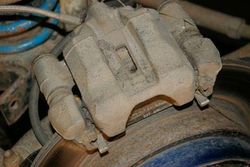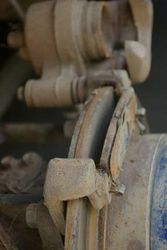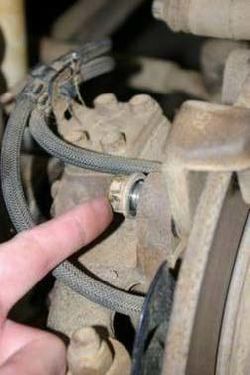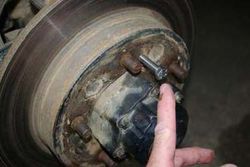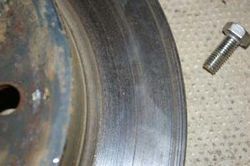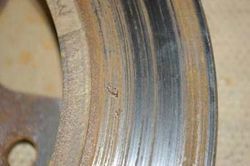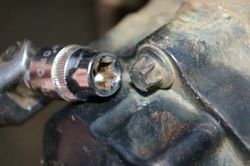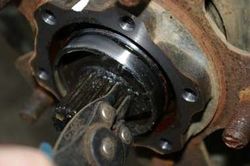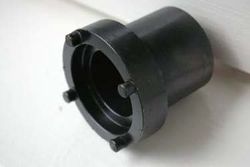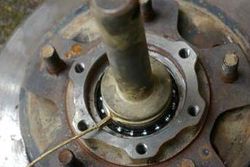![]() The content of any article might be expanded / improved in the future - revisit it sometimes.
The content of any article might be expanded / improved in the future - revisit it sometimes.
![]() Seen a mistake? Know something that isn't written? Edit and change this article yourself!
Seen a mistake? Know something that isn't written? Edit and change this article yourself!
![]() Some images in the article (if present) can be enlarged by clicking on them.
Some images in the article (if present) can be enlarged by clicking on them.
Contents
Introduction
The Front Wheel Bearings on a Jimny can be prone to wearing, particularly when used off-road or when using oversized tyres and/or wheel spacers.
If you have the correct tools, replacing a front wheel bearing can be a straight forward task.
It is also closely tied in with changing/working on the kingpin bearings, so some of the steps are duplicated.
The general symptoms of worn wheel bearings:
- Grating/Grinding as you rotate a jacked up wheel
- Steering Shimmy, see Death Wobble
- Oil/Grease leaking from Swivel Joint
- Horizontal play in the front wheel
- With the car jacked up, grip the wheel sides - there will be movement if they are worn.
- Get an assistant to press the brakes while you are shaking the wheel - the movement should disappear.
- With the car jacked up, grip the wheel sides - there will be movement if they are worn.
- It is also common not to experience any play at all and to even pass an MOT with a really bad bearing.
- This is because the Jimny front wheel bearings have dual inner race and only one race may have failed.
Prerequisites
Before embarking onto any work, first comes the overview of the prerequisites.
Required parts
The table
| Part name | Quantity | Suzuki P.N. | Aftermarket replacements | Comments |
|---|---|---|---|---|
| Wheel bearing |
1 piece | 43462-84A00 | Various | Suzuki actually uses Koyo "DAC4168W HR4CS23" bearing under the stated OEM P.N. |
| Bearing oil seal |
1 piece | 09283-54001 | Various | This part is usually available in the aftermarket only in a set together with the bearing. Suzuki originally used the seal with inscriptions "Koyo" and "MHRD 54 69 7.5-9.5SJ" in a Jimny made in 2007. |
| C-clip | 1 piece | 09381-68001 | Various | This part is usually available in the aftermarket only in a set together with the bearing. |
| Bearing grease |
A fistful or so |
? | Various | Sometimes comes together with the bearing (otherwise use a high quality grease which is suitable for the application). |
| A calendar with pictures of (half)naked women |
12 pictures / months |
Probably with portraits of Suzuki's female employees |
|
|
Parts offered in BigJimny Store
The BigJimny Store has the following parts from the above table on sale:
- A complete 3-piece kit (wheel bearing + oil seal + C-clip).
- Sorry, no calendars with pictures of naked women (nor men for that matter) are in store's offer (yet)!
Required tools
- Standard metric sockets and spanners
- Assorted screwdrivers
- Hub nut unlock tool
- Circlip pliers (External)
- An E10 Torx socket for the Vacuum Hub Bolts
- A ball joint splitter
- 1" Imperial Socket
- G-Clamp or brake piston retractor
![]() You will definitely need the special tool to release the locking hub nut.
You will definitely need the special tool to release the locking hub nut.
Alternatively, you can hire a sorcerer specialized in mechanics.
(An ordinary magician won't suffice.)
Replacement procedure
Removing the Caliper and pads
- First of all secure the car, release the wheel nuts and jack up the car and remove the road wheel.
- This then reveals the brake caliper, this is the passenger side (nearside) caliper (UK)
- Using a 12mm spanner, release the front caliper bolt (the left is the front of the car in this picture).
- Then loosen the same bolt on the rear of the caliper.
- The caliper then opens up using the rear bolt as a hinge.
- The pads are retained by small spring clips.
- A simple pull on the pads (horizontally away from the disk) should remove them.
- If the pads resist, gently prise out the pads with a small screwdriver - do not remove the spring clips.
- If you require new pads, spring clips or a caliper fitting kit then these are available in the BigJimny Store.
Removing the Brake Disc
- The caliper is held on with two bolts at the rear.
- Release the bolts and tie the caliper to the spring to keep it out of the way.
- Now the front brake disc can be removed.
- If you are lucky it will simply pull off but if you have problems then there are two M8 holes in the disk hub.
- Simply run two bolts into these holes and the disk will push off the hub.
- The picture shows a bolt being used to push the disk off the hub.
My disk appeared to be ok on the visible side but the rear showed some bad wear so I will change them as part of this job.
New disks are available in the BigJimny Store.
Dismantling the Hub
- Now the Freewheeling Hub needs to be removed.
- Suzuki have used Torx bolts to secure these so you will require an E10 socket to remove the bolts.
- With the hub removed the driveshaft is exposed.
- The driveshaft is retained with a circlip so use a pair of circlip pliers to remove it.
- This is really fiddly and can be an annoying task.
- Behind the circlip is a rectangular washer that should also be removed.
- Note that I have also marked with white paint the orientation of the freewheeling hub, this is not strictly needed.
- Now for the special tool.
- The hub is held on by a special round nut that requires a special tool to release it.
- The outside of the nut is a smooth polished ring which is part of the vacuum seal so it must not be damaged.
- Otherwise you will need a new nut (which is exceedingly expensive!).
- In the centre of the nut, the edge is bent over into a slot to help secure it.
- The slot can be seen in the photo in the “2 o’clock” position.
- Use a blade to bend the edge back into line.
- It is essential that this is completely free, otherwise it is impossible to undo the nut and you will break the tool.
- This is the tool.
- It is available from the BigJimny Store.
- Make sure that the tool and the nut are completely clean as the tool will not fit.
- Make sure the tool is inserted into the nut correctly with the pins all in the holes in the nut.
- You are really going to have to swing on the nut to release it.
- I had to use a long breaker bar AND a piece of scaffold tube.
- With the nut removed the hub should be removeable, it might need a pull with a slide hammer, mine just pulled off by hand.
- With the hub face down on a surface you can now remove the bearing seal from the rear of the hub.
- I prised mine out with a screwdriver.
- Then you can use a pair of long nose pliers to remove the C-Clips that retain the bearing.
- Note that these may be corroded in and difficult to even see at first.
- Now comes the first bit that is supposed to be difficult.
- Suzuki say that the bearing needs to be removed using a press.
- I decided to have a go myself - using an old piece of bearing and a steel pin I hammered out the bearing and it only took two or three swift blows.
- The picture shows the steel pin resting on the bearing before being hit.
- Note the use of the brake disk to provide a holder for the hub allowing the bearing to be driven out of the bottom.
- The bearings are Koyo brand as standard.
- The BigJimny store has a kit available which includes the seal and the c-clips (not all kits contain the c-clips), the Wheel Bearing Kit is here.
The rebuild
- Suzuki says the new bearing needs to be pressed into place.
- I decided to try a bit of school boy physics.
- I coated the bearing in Copper Grease and then put it in the deep freeze overnight.
- The hub was placed in the oven at 180 degrees for 30 minutes.
- So with an ice cold bearing and a very hot hub I put the bearing in the hub, placed the old bearing ring and the steel pin on top and tapped the bearing straight into place.
- It took two gentle hits!
- Again note the use of the brake disk to hold the hub.
- Once it is cooled put grease into the ends of the bearing.
- Then insert the new circlip and the oil seal.
- I found that the oil seal pressed in ok by hand once coated in Copper Grease.
- The oil seal has a protruding lip, this must be to the outside of the joint.
- Grease the inside of the bearing and slide the hub back onto the driveshaft.
- Grease the hub nut and tighten the nut using the special tool
- Torque it to 220NM or 160ft lbs – ie. really tight!.
- Use a punch to bend the inner lip of the nut to lock it in place.
- Refit the hub thrust washer and circlip to the driveshaft.
- Fit the disk and fit the caliper (Caliper bolts 61ft/lbs), brake pads and bolt the caliper down in position (Caliper pin bolt 16/ft/lbs)
- Re-fit the wheel and lower the vehicle.
Torque Settings
Full details of the torque settings can be found in the reference data
Page last edited on 1/12/2018 by user Bosanek


